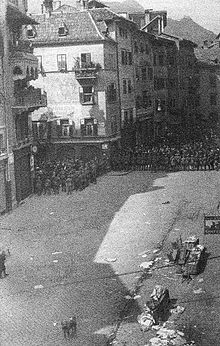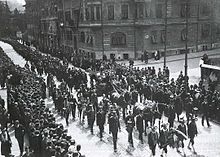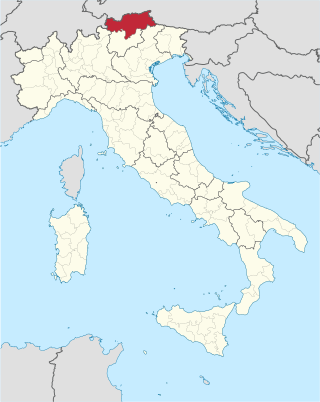
South Tyrol is an autonomous province in northern Italy. An English translation of the official German and Italian names could be the Autonomous Province of Bolzano – South Tyrol, reflecting the multilingualism and different naming conventions in the area. Together with Trentino, South Tyrol forms the autonomous region of Trentino-Alto Adige/Südtirol. The province is the northernmost of Italy, the second largest with an area of 7,400 square kilometres (2,857 sq mi), and has a total population of about 534,000 inhabitants as of 2021. Its capital and largest city is Bolzano.
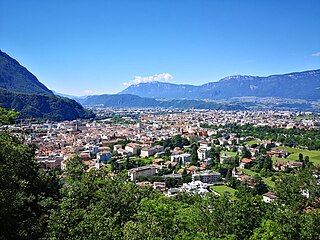
Bolzano is the capital city of South Tyrol, Northern Italy. With a population of 108,245, Bolzano is also by far the largest city in South Tyrol and the third largest in historical Tyrol. The greater metro area has about 250000 inhabitants and is one of the urban centres within the Alps.

Trentino-Alto Adige/Südtirol is an autonomous region of Italy, located in the northern part of the country. The region has a population of 1.1 million, of whom 62% speak Italian as their mother tongue, 30% speak South Tyrolean German and several foreign languages are spoken by immigrant communities. Since the 1970s, most legislative and administrative powers have been transferred to the two self-governing provinces that make up the region: the province of Trento, commonly known as Trentino, and the province of Bolzano, commonly known as South Tyrol. In South Tyrol, German remains the sizeable majority language.
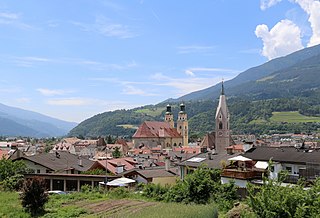
Brixen is a town and commune in South Tyrol, northern Italy, located about 40 kilometres (25 mi) north of Bolzano.

The South Tyrol Option Agreement was an agreement in effect between 1939 and 1943, when the native German and Ladin-speaking people in South Tyrol and several other municipalities of northern Italy, which had belonged to Austria before WWI, were given the option of either emigrating to neighboring Nazi Germany or remaining in Fascist Italy, where the German minority was subjected to repressive Italianization efforts.
Katakombenschulen were clandestine schools established in Italian South Tyrol during the 1920s period of Fascist Italianization.
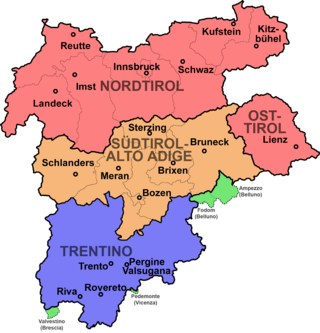
Modern-day South Tyrol, an autonomous Italian province created in 1948, was part of the Austro-Hungarian County of Tyrol until 1918. It was annexed by Italy following the defeat of the Central Powers in World War I. It has been part of a cross-border joint entity, the Euroregion Tyrol-South Tyrol-Trentino, since 2001.

Salorno sulla Strada del Vino is the southernmost comune (municipality) and a village in South Tyrol in northern Italy, located about 30 kilometres (19 mi) southwest of the city of Bolzano. It is one of only five mainly Italian-speaking municipalities in South Tyrol.
The South Tyrolean Liberation Committee was an underground secessionist and terrorist organisation founded by Sepp Kerschbaumer and several combatants including Georg Klotz in the mid-1950s which aimed to achieve the right for self-determination for South Tyrol and the related secession from Italy via bomb attacks.

In 1919, at the time of its annexation, the middle part of the County of Tyrol which is today called South Tyrol was inhabited by almost 90% German speakers. Under the 1939 South Tyrol Option Agreement, Adolf Hitler and Benito Mussolini determined the status of the German and Ladin (Rhaeto-Romanic) ethnic groups living in the region. They could emigrate to Germany, or stay in Italy and accept their complete Italianization. As a consequence of this, the society of South Tyrol was deeply riven. Those who wanted to stay, the so-called Dableiber, were condemned as traitors while those who left (Optanten) were defamed as Nazis. Because of the outbreak of World War II, this agreement was never fully implemented. Illegal Katakombenschulen were set up to teach children the German language.

The Bozner Bergsteigerlied is one of the two unofficial hymns of the South Tyroleans, the other being the Andreas-Hofer-Lied. Its lyrics were composed in 1926 by Karl Felderer in Moos am Ritten to the melody of an old Tyrolean craftsmen's song.
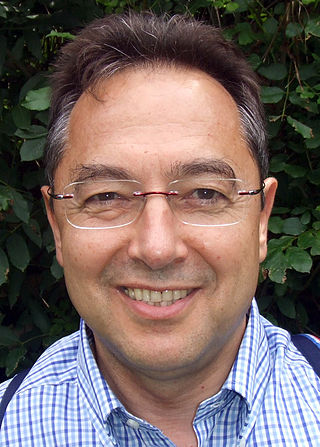
Oskar Peterlini is an Italian political writer and Lecturer at the Free University of Bozen Bolzano.

Bolzano/Bozen railway station is the main station of Bolzano, capital of the autonomous province of South Tyrol, in northeastern Italy.
The South Tyrolean Unterland or Bozen Unterland is a section of the Etschtal valley stretching from the regional capital Bolzano (Bozen) down the Adige (Etsch) river to Tramin and Salorno (Salurn). The area is known for its history, particularly regarding Rhaetic, Roman, and Germanic archaeological sites; its bilingualism, and its viticulture; the Gewürztraminer grape originated here.

Julius Perathoner was an Austro-Hungarian politician who became an Italian citizen after the Treaty of Saint-Germain. He was one of the most important exponents of the Liberal Party in Tyrol and the last mayor of German ethnicity of the City of Bolzano from 1895 to 1922. On October 3, 1922 the democratically elected Perathoner was forcibly deposed as mayor during the March on Bozen from Italian fascists and replaced by a fascist functionary.
Franz Thaler was an author from South Tyrol, a peacock quill embroiderer and a survivor of the concentration camp in Dachau and satellite camp in Hersbruck.
The following is a timeline of the history of the city of Bolzano/Bozen in the Trentino-South Tyrol region of Italy.
The Deutscher Verband was a coalition of bourgeois German-speaking political parties that was formed in South Tyrol in 1919 after the region was annexed by Italy. It was a merger of the Catholic Tiroler Volkspartei and the national liberal Deutschfreiheitliche Partei. The German-speaking Social Democrats, for their part, joined with the Italian Socialist Party.
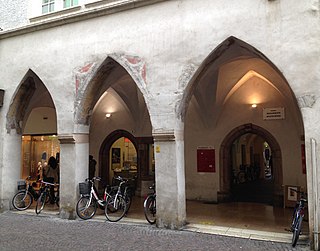
The Civic Archives in Bozen-Bolzano is the municipal archive of the city of Bolzano in South Tyrol, Italy. It is located in the old town hall and stores documents from over 700 years of civic and regional history.

The cathedral Maria Himmelfahrt is the parish church of the South Tyrolean capital Bolzano and cathedral of the Diocese of Bozen-Brixen. While the Bishop has resided in Bozen since 1964, the cathedra and the cathedral chapter remain in Brixen. Maria Himmelfahrt is therefore with Brixen Cathedral co-cathedral of the diocese.
